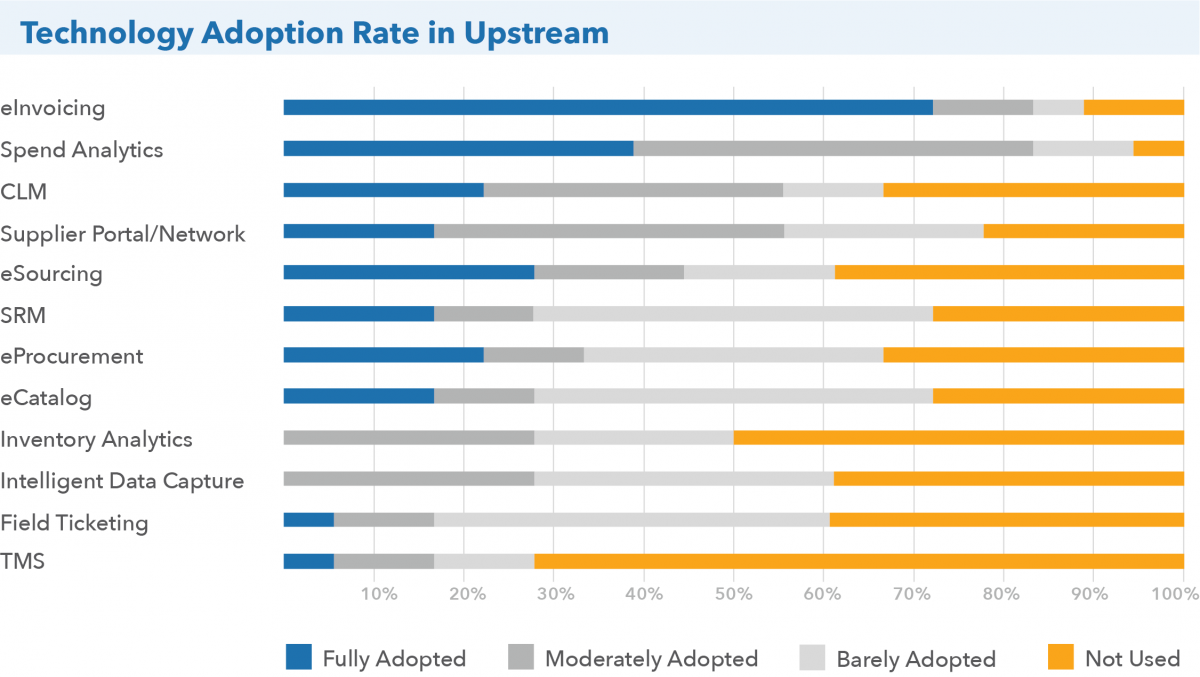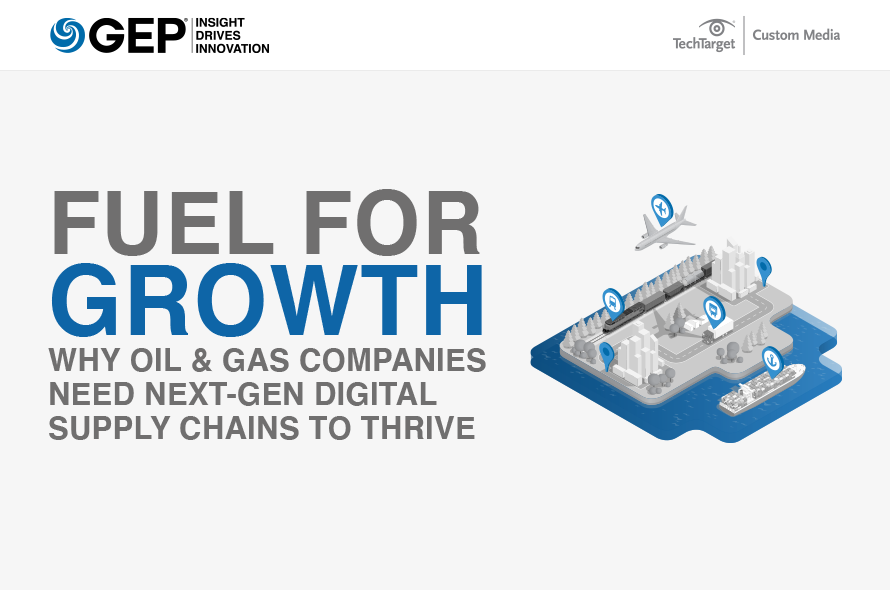You can’t afford inefficiencies in the oil and gas business. Amid price and demand volatility, not having real-time visibility and control on the supply chain can lead to wasteful spending and loss of productivity. How do you avoid this?
A new white paper from GEP and TechTarget — Fuel for Growth: Why Oil & Gas Companies Need Next-Gen Digital Supply Chains to Thrive — looks at the two key elements in modernizing the upstream supply chain ecosystem: data quality and data visibility.
And the most efficient way to achieve these is by tightly integrating supply chain and procurement under a unified data-driven software platform built on cloud delivery to quickly improve operations and margins.
What’s Inside:
- Ways to improve data capture with intuitive tech
- How to leverage automation to cut cost and risk
- How to optimize supply chain operations with analytics
This is a must-read paper for supply chain leaders in the oil and gas industry looking to save on spend and increase efficiency in their upstream operations.
THE NEED TO FOCUS ON DATA QUALITY AND VISIBILITY
Without trust in the data, usability is poor, and many potential technology innovations haven’t been fully adopted by end users to drive value for the enterprise. The chart below from GEP Analysis illustrates the poor levels of upstream adoption in many key areas.
Lack of trust in data quality and visibility is a huge problem in an industry as widely distributed and fast-moving as petroleum. It leads to hundreds of millions of dollars in wasteful spending every year and ineffective working capital management. Given today’s market conditions and shrinking margins, vendors can ill afford that level of waste and inefficiency.
Plugging in point solutions to existing infrastructure may address individual problems but leaves the overall supply chain siloed and fragmented. With a stopgap approach, oil and gas companies can’t come close to optimizing their operations or their investments in digital technologies.
The situation will continue to devolve if challenges are not addressed quickly, particularly with the growth of mobility, the Internet of Things, big data analytics, machine learning and other potentially disruptive technology innovations.
There has to be a better way, and there is.
By moving to a modern, data-driven solution built on integrated software and cloud delivery, oil and gas companies can tightly integrate supply chain and procurement management under a single platform to maximize revenue, minimize risk and optimize productivity.
With the right solution, the supply chain can leverage accurate, real-time data, tight integration and unprecedented visibility to resolve key issues across operations, material fulfillment, inventory and margins.

FIGURE 1
KEY CHALLENGES
If the goal is to keep pumping money out of the ground, oil and gas companies have important obstacles to overcome, namely:
- Minimizing and eliminating downtime in the field. This risk of shutting down a drill rig, even in these slow times, can easily cost $100,000 a day. Do you really want to pay that steep price because you can’t get the proper materials to the right place at the right time? This should weigh heavily when balanced against the benefits of data-driven, right-size unit pricing, inventory holding and delivery timing.
- Optimizing inventory location to quickly serve the material needs on the platforms or pads to reduce drag on time-sensitive projects.
- Providing seamless visibility with drilling-plan-to-material and service-fulfillment execution.
- Predicting and mitigating material shortfalls caused by outside factors such as sand shortages or hurricanes.
- Achieving the agility to adjust when actual drilling progress and expenditures differ from plans.
- Integrating multiple legacy applications to allow real-time planning input to be fed to scheduling—and, ultimately, to procurement and supply chain users—to optimize productivity across the value chain.
THE BUSINESS VALUE OF SUPPLY CHAIN MODERNIZATION
Moving to a modern, data-driven, integrated supply chain and procurement platform can resolve these issues. With the right solution, oil and gas companies can address critical challenges in the following areas:
- Operations: Close the disconnect between demand fluctuations and corresponding supply operations. Manage the high variance of geology-driven plan deviation and changes in capacity, while resolving issues with suppliers, orders and warehousing quickly and collaboratively.
- Material fulfillment: Use real-time data to adjust to unexpected demand spikes or surprise operational changes. Share information digitally with supply chain organizations and suppliers. Gain visibility to alternative fulfillment options from trusted sources and use real-time consistent data for order fulfillment and timing.
- Inventory: Accurately match location to demand and mitigate stock-out and overstock issues caused by a lack of demand and supply information. Increase visibility of capitalized project stock across the supply chain and use data to manage and mitigate inventory obsolescence.
- Margin: Minimize margin erosion by limiting costs associated with excessive direct materials and inventory write-offs. Increase productivity by reducing non-productive time caused by missing material. Reduce the costs of audits and contract noncompliance.
WHAT TO LOOK FOR IN A PLATFORM
The only way to truly achieve these benefits is to deploy a platform that enables you to overcome the existing challenges of data quality and visibility. Overall, the solution should enable you to achieve enterprise-wide supply chain and procurement capabilities across three main areas:
- Improved data capture. The sooner you are able to capture data and access it, the better the quality of that data. Data capture should be easy, global and intuitive, using technologies such as geosensing and RFID to keep it current and clean. This is essential because it will give decision-makers increased confidence in the quality of the data and thus help overcome the challenge of user adoption.
- Pervasive automation. If you start with quality data you can trust, you need to make sure your systems are unified so you can fully leverage automation to reduce costs, risk, waste and inefficiencies across the entire supply chain. This means using a platform that links procurement systems with maintenance, ERP and other key operational systems. The last thing you want is to stop an order because workers have to manually input data and information that can be better handled with more accuracy, timeliness and efficiency by machines.
- Operational optimization. Once you have addressed the challenges of data quality, visibility and automation, you can really start to optimize the true benefits of your system to drive revenue and earnings per share. In other words, the ability to truly leverage your data is the path to minimizing stoppages, delays and waste while maximizing intelligence, analytics and, ultimately, return on investment.

FIGURE 2
KEY CAPABILITIES FOR THE OIL AND GAS INDUSTRY
Today’s reality is that very few solutions can give you this level of data quality, visibility and integration across your entire supply chain and procurement ecosystem.
Many legacy ERP vendors have installed bases to protect and have been slow to move to the cloud. They also benefit by having closed platforms that don’t easily integrate across the broad spectrum required of today’s broad, diverse and digital petroleum supply chains.
When evaluating potential solutions, start with a platform that is open, data driven and cloud enabled. Also look for a solution that allows you to migrate at your own pace, leveraging existing investments without having to rip and replace what you already have in place.
Key capabilities to demand are:
- Real-time data visibility across enterprise and supplier systems for inventory, bulk materials and contractors.
- Offline-enabled, mobile-first visibility and execution layers.
- Ease of integration to link procurement to inventory before ordering, for example.
- Ease of incremental deployment.
- Material handling and inventory optimization.
- Integrated activity planning.
- Analytics-driven optimization of full logistics network.
- Automated, data-driven ordering to maintain optimal stocking.
- Automatic support for manual order requests.
- End-to-end tracking of all materials and equipment required for a job.
- In-field tracking of contractor and vendor movements and utilization.
TAKING THE NEXT STEP
When it comes to digital supply chain modernization, GEP is the provider that truly understands the challenges facing oil and gas companies in their supply chains and that offers a next-generation, integrated, data-driven path forward for all companies across the petroleum industry.
GEP NEXXE, a unified and comprehensive supply chain platform, is built on a foundation of big data and leverages machine learning at its core. GEP NEXXE is designed for ease of integration and ease of incremental adoption, allowing petroleum companies to streamline their technology portfolio without risking existing operations.
For more information on how your organization can modernize its supply chain to “keep pumping more money out of the ground,” please visit GEP to learn more about our comprehensive solutions for the oil and gas industry.

